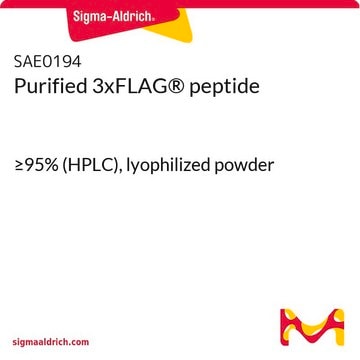FLAGIPT1
FLAG® Immunoprecipitation Kit
Sinónimos:
Anti-ddddk, Anti-dykddddk
Iniciar sesiónpara Ver la Fijación de precios por contrato y de la organización
About This Item
Código UNSPSC:
12352200
NACRES:
NA.32
Productos recomendados
uso
kit sufficient for 50 reactions
Nivel de calidad
clases químicas de analitos
proteins (FLAG® Affinity Gels)
técnicas
immunoprecipitation (IP): suitable
Condiciones de envío
wet ice
temp. de almacenamiento
−20°C
Descripción general
Sigma′s FLAG Immunoprecipitation kit allows a rapid and efficient immunoprecipitation and elution of an active FLAG-tagged protein. The immunoprecipitation is performed with the ANTI-FLAG M2 affinity gel, which is a highly specific monoclonal antibody covalently attached to agarose resin. The use of affinity resin allows an efficient binding of FLAG-tagged proteins without the need for preliminary steps and calibrations. The immunoprecipitated FLAG-tagged proteins can be efficiently eluted from the resin with acidic conditions or by competition with FLAG peptide. The immunoprecipitated proteins can be detected for their size, post-translational modifications, and interactions on gel electrophoresis, and by activity assays.
Aplicación
Learn more product details in our FLAG® application portal.
Características y beneficios
- Utilizes highly specific ANTI-FLAG M2 affinity gel
- No preliminary steps or calibrations
- 3X FLAG™ peptide provides efficient and gentle elution through direct competition
Otras notas
All prodedures to be performed at 2-8°C.
Información legal
3xFLAG is a trademark of Sigma-Aldrich Co. LLC
FLAG is a registered trademark of Merck KGaA, Darmstadt, Germany
Producto relacionado
Referencia del producto
Descripción
Precios
Palabra de señalización
Warning
Frases de peligro
Consejos de prudencia
Clasificaciones de peligro
Aquatic Chronic 3 - Eye Irrit. 2
Código de clase de almacenamiento
10 - Combustible liquids
Certificados de análisis (COA)
Busque Certificados de análisis (COA) introduciendo el número de lote del producto. Los números de lote se encuentran en la etiqueta del producto después de las palabras «Lot» o «Batch»
¿Ya tiene este producto?
Encuentre la documentación para los productos que ha comprado recientemente en la Biblioteca de documentos.
Los clientes también vieron
Konstantinos Koudounas et al.
Plant physiology, 174(3), 1371-1383 (2017-05-10)
Oleuropein, a terpene-derived glycosylated secoiridoid biosynthesized exclusively by members of the Oleaceae family, is involved in a two-component defense system comprising a β-glucosidase that activates oleuropein into a toxic glutaraldehyde-like structure. Oleuropein and its deglycosylated derivatives have high pharmaceutical interest.
Mercedes Rodriguez-Teja et al.
Molecular cancer research : MCR, 13(3), 538-547 (2014-11-09)
Epithelial cell-cell contacts maintain normal glandular tissue homeostasis, and their breakage can trigger epithelial-to-mesenchymal transition (EMT), a fundamental step in the development of metastatic cancer. Despite the ability of C-type lectin domains (CTLD) to modulate cell-cell adhesion, it is not
Kuancan Liu et al.
Molecular therapy : the journal of the American Society of Gene Therapy, 28(3), 901-913 (2020-01-29)
Esophageal squamous cell carcinoma (ESCC) is a predominant cancer type in developing countries such as China, where ESCC accounts for approximately 90% of esophageal malignancies. Lacking effective and targeted therapy contributes to the poor 5-year survival rate. Recent studies showed
Andrew S Terker et al.
American journal of physiology. Renal physiology, 315(4), F781-F790 (2018-02-08)
With no lysine kinase 4 (WNK4) is essential to activate the thiazide-sensitive NaCl cotransporter (NCC) along the distal convoluted tubule, an effect central to the phenotype of familial hyperkalemic hypertension. Although effects on potassium and sodium channels along the connecting
Samer Swedan et al.
Journal of virology, 85(19), 10090-10100 (2011-07-29)
Human respiratory syncytial virus (RSV), a major cause of severe respiratory diseases, efficiently suppresses cellular innate immunity, represented by type I interferon (IFN), using its two unique nonstructural proteins, NS1 and NS2. In a search for their mechanism, NS1 was
Nuestro equipo de científicos tiene experiencia en todas las áreas de investigación: Ciencias de la vida, Ciencia de los materiales, Síntesis química, Cromatografía, Analítica y muchas otras.
Póngase en contacto con el Servicio técnico













